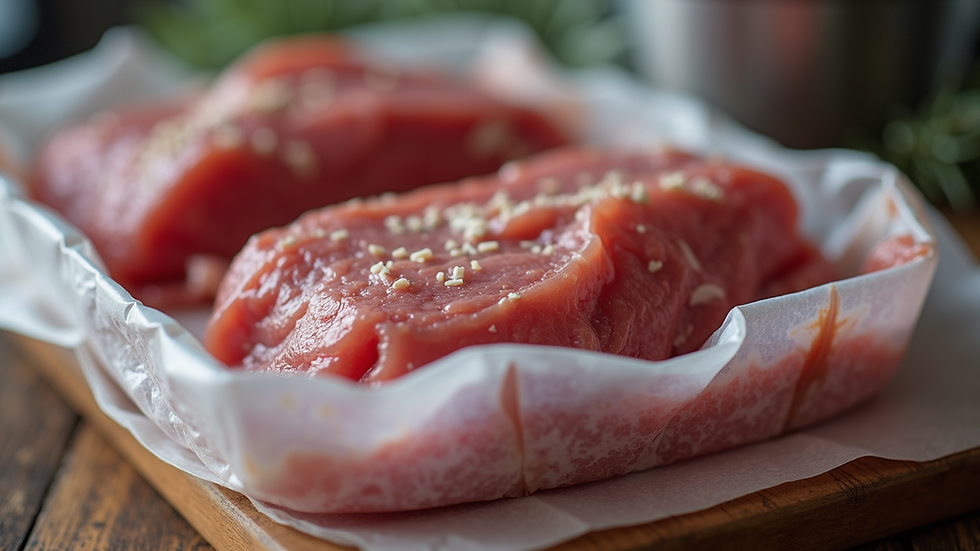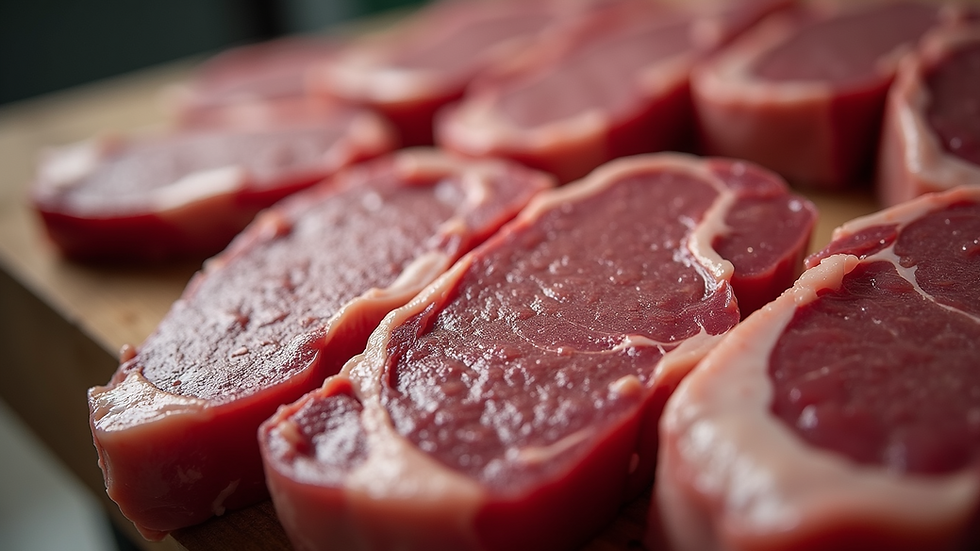Sourcing Premium Buffalo Meat for Global Export
- brglobaldataentry
- Aug 12
- 4 min read
In recent years, the demand for premium buffalo meat has surged across the globe. This rise is not just a trend; it reflects a growing appreciation for the unique flavor and nutritional benefits of buffalo meat. As consumers become more health-conscious, they are seeking alternatives to traditional beef. Buffalo meat is leaner, lower in cholesterol, and packed with essential nutrients.
This blog post will explore the ins and outs of sourcing premium buffalo meat for global export. We will discuss the benefits of buffalo meat, the sourcing process, quality control measures, and the logistics involved in exporting this sought-after product.
Understanding the Benefits of Buffalo Meat
Buffalo meat is not only delicious but also offers numerous health benefits. Here are some key points to consider:
Nutritional Value: Buffalo meat is rich in protein, iron, and vitamins. It contains less fat than beef, making it a healthier choice for consumers.
Sustainability: Buffalo are often raised in more sustainable farming practices compared to cattle. They require less water and can thrive on less land.
Flavor Profile: The taste of buffalo meat is distinct and often described as richer and more robust than beef. This unique flavor can enhance various dishes, making it a favorite among chefs and home cooks alike.
These benefits make buffalo meat an attractive option for consumers looking for healthier and more sustainable meat choices.
The Sourcing Process
Sourcing premium buffalo meat involves several steps. Here’s a breakdown of the process:
1. Identifying Reliable Suppliers
Finding trustworthy suppliers is crucial. Look for farms that prioritize animal welfare and sustainable practices. Research their farming methods and ensure they adhere to health and safety regulations.
2. Establishing Relationships
Building strong relationships with suppliers can lead to better pricing and quality assurance. Regular communication helps in understanding their production capabilities and any challenges they may face.
3. Quality Assessment
Before finalizing any deals, conduct a thorough quality assessment. This includes:
Visual Inspection: Check for color, texture, and overall appearance.
Taste Testing: If possible, sample the meat to ensure it meets your standards.
Certifications: Verify that the meat is certified organic or meets other relevant standards.
4. Negotiating Contracts
Once you have identified a reliable supplier, negotiate contracts that outline pricing, delivery schedules, and quality expectations. Clear agreements help prevent misunderstandings later on.
Quality Control Measures
Quality control is essential in the meat industry. Here are some measures to ensure the buffalo meat you source is of the highest quality:
1. Regular Inspections
Conduct regular inspections of the meat processing facilities. This ensures that hygiene standards are maintained and that the meat is handled properly.
2. Testing for Contaminants
Implement testing protocols to check for contaminants such as bacteria or harmful substances. This is vital for ensuring the safety of the meat.
3. Traceability
Establish a traceability system that allows you to track the meat from farm to table. This builds trust with consumers and helps in addressing any potential issues.
Logistics of Exporting Buffalo Meat
Exporting buffalo meat involves navigating various logistical challenges. Here are some key considerations:
1. Understanding Regulations
Each country has its own regulations regarding meat imports. Familiarize yourself with these rules to ensure compliance. This includes understanding labeling requirements and health certifications.
2. Packaging and Preservation
Proper packaging is crucial for maintaining the quality of buffalo meat during transport. Use vacuum-sealed packaging to preserve freshness and prevent spoilage.
3. Shipping Methods
Choose the right shipping method based on the destination and urgency. Options include air freight for faster delivery or sea freight for cost-effective solutions.
4. Customs Clearance
Work with a customs broker to navigate the complexities of customs clearance. This ensures that all necessary documentation is in order, preventing delays at the border.
Marketing Premium Buffalo Meat
Once you have sourced and exported buffalo meat, the next step is marketing it effectively. Here are some strategies to consider:
1. Highlight Health Benefits
Emphasize the health benefits of buffalo meat in your marketing materials. Use social media, blogs, and newsletters to educate consumers about its nutritional value.
2. Collaborate with Chefs
Partnering with chefs can help promote buffalo meat in restaurants. Offer samples to local chefs and encourage them to create unique dishes featuring buffalo meat.
3. Attend Trade Shows
Participate in food trade shows to showcase your buffalo meat products. This is an excellent opportunity to network with potential buyers and distributors.
4. Utilize Online Platforms
Leverage e-commerce platforms to reach a broader audience. Create an engaging website that highlights your products and allows for easy online ordering.
Challenges in Sourcing and Exporting
While sourcing and exporting buffalo meat can be rewarding, it is not without challenges. Here are some common issues you may encounter:
1. Supply Chain Disruptions
Global events can disrupt supply chains, affecting the availability of buffalo meat. Stay informed about market trends and have contingency plans in place.
2. Price Fluctuations
The price of buffalo meat can fluctuate due to various factors, including feed costs and demand. Monitor market conditions to adjust your pricing strategy accordingly.
3. Competition
As the demand for buffalo meat grows, so does the competition. Differentiate your products by focusing on quality, sustainability, and unique marketing strategies.
The Future of Buffalo Meat Exports
The future of buffalo meat exports looks promising. As more consumers seek healthier and sustainable meat options, the demand for buffalo meat is expected to rise.
Investing in quality sourcing, effective marketing, and strong relationships with suppliers will be key to success in this growing market.

In conclusion, sourcing premium buffalo meat for global export is a multifaceted process that requires careful planning and execution. By understanding the benefits of buffalo meat, establishing strong supplier relationships, implementing quality control measures, and navigating the logistics of export, you can successfully tap into this lucrative market.
As the world continues to embrace healthier eating habits, buffalo meat stands out as a top choice. With the right strategies in place, you can position yourself as a leader in the buffalo meat export industry.





Comments